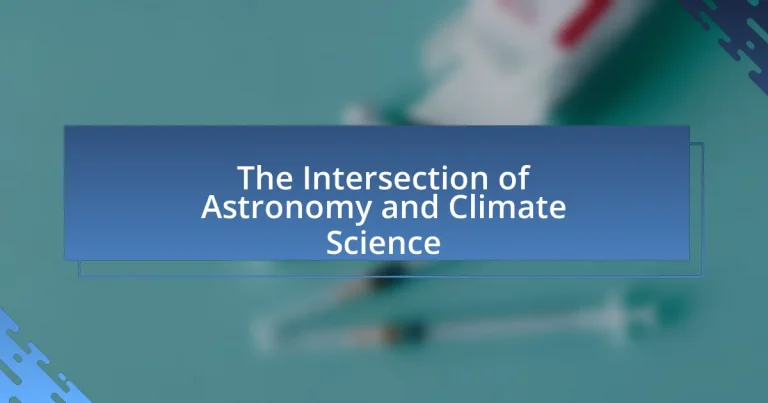The article explores the intersection of astronomy and climate science, emphasizing how celestial phenomena influence Earth’s climate systems. It discusses key concepts such as solar radiation, planetary albedo, and orbital mechanics, highlighting their roles in climate variability and historical climate shifts. The article also examines how astronomical observations enhance climate modeling and predictions, the implications for environmental policy, and the importance of interdisciplinary collaboration in addressing climate change. Additionally, it outlines practical steps for leveraging astronomical data in climate action and the challenges faced in integrating these two fields.

What is the Intersection of Astronomy and Climate Science?
The intersection of astronomy and climate science lies in understanding how celestial phenomena influence Earth’s climate systems. For instance, variations in solar radiation, driven by solar cycles, can impact global temperatures and climate patterns. Research indicates that changes in solar output correlate with historical climate shifts, such as the Little Ice Age, where reduced solar activity coincided with cooler temperatures on Earth. Additionally, astronomical events like volcanic eruptions can inject aerosols into the atmosphere, affecting climate by reflecting sunlight. These connections highlight the importance of astronomical factors in shaping Earth’s climate and underscore the need for interdisciplinary approaches in climate research.
How do astronomy and climate science relate to each other?
Astronomy and climate science relate to each other through the study of celestial influences on Earth’s climate. For instance, variations in solar radiation, driven by solar cycles, directly affect Earth’s temperature and climate patterns. Research indicates that changes in solar output can lead to significant climate shifts, such as the Little Ice Age, which was influenced by reduced solar activity. Additionally, astronomical phenomena like volcanic eruptions on other planets provide insights into atmospheric processes that can be analogous to Earth’s climate systems. Thus, understanding these celestial factors is crucial for comprehending and predicting climate changes on Earth.
What are the key concepts in astronomy that impact climate science?
Key concepts in astronomy that impact climate science include solar radiation, planetary albedo, and orbital mechanics. Solar radiation is the primary energy source for Earth’s climate system, influencing temperature and weather patterns. Variations in solar output, such as those observed during solar cycles, can lead to significant climate changes, as evidenced by historical climate data correlating solar activity with temperature fluctuations. Planetary albedo refers to the reflectivity of Earth’s surface, which affects how much solar energy is absorbed versus reflected back into space. Changes in land use, ice cover, and cloud formation can alter albedo, impacting global temperatures. Orbital mechanics, particularly the Milankovitch cycles, describe how variations in Earth’s orbit and axial tilt affect climate over long periods, contributing to glacial and interglacial cycles. These astronomical factors are crucial for understanding both current climate dynamics and long-term climate trends.
How does climate science benefit from astronomical observations?
Climate science benefits from astronomical observations by gaining insights into Earth’s climate systems through the study of celestial phenomena. For instance, observations of solar radiation and its variations help scientists understand the Sun’s influence on climate patterns, such as the correlation between solar cycles and temperature changes on Earth. Additionally, data from satellites, which monitor atmospheric conditions and greenhouse gas concentrations, provide critical information for climate modeling and forecasting. This integration of astronomical data enhances the accuracy of climate predictions and informs strategies for mitigating climate change impacts.
Why is understanding this intersection important?
Understanding the intersection of astronomy and climate science is important because it reveals how cosmic events influence Earth’s climate systems. For instance, solar radiation variations, driven by solar cycles, can significantly impact global temperatures and weather patterns. Research indicates that changes in solar output correlate with climate shifts, such as the Little Ice Age, which was influenced by reduced solar activity. This understanding helps scientists predict future climate scenarios and informs policy decisions regarding climate change mitigation and adaptation strategies.
What implications does this intersection have for environmental policy?
The intersection of astronomy and climate science has significant implications for environmental policy, particularly in understanding climate change drivers and predicting future environmental conditions. For instance, astronomical phenomena such as solar cycles can influence Earth’s climate patterns, which policymakers must consider when developing strategies for climate mitigation and adaptation. Research indicates that variations in solar radiation can affect global temperatures, as evidenced by historical climate data correlating solar activity with temperature fluctuations over centuries. Therefore, integrating astronomical insights into climate models can enhance the accuracy of climate predictions, guiding more effective environmental policies.
How can this knowledge influence public awareness of climate issues?
Knowledge of the intersection of astronomy and climate science can significantly enhance public awareness of climate issues by illustrating the broader cosmic context of Earth’s climate. For instance, understanding how solar activity influences climate patterns can help the public grasp the complexities of climate change beyond human factors. Research indicates that variations in solar radiation can affect Earth’s temperature, as shown in studies like “Solar Influence on Climate” by Lockwood and Fröhlich, which highlights the role of solar cycles in climate variability. This knowledge empowers individuals to recognize the multifaceted nature of climate change, fostering informed discussions and encouraging proactive engagement in climate action.

What are the main astronomical phenomena affecting climate science?
The main astronomical phenomena affecting climate science include solar radiation variations, Earth’s axial tilt, and orbital eccentricity. Solar radiation variations, primarily influenced by sunspot cycles, affect the amount of solar energy reaching Earth, impacting global temperatures. Earth’s axial tilt, or obliquity, alters seasonal climate patterns over a 41,000-year cycle, influencing temperature distribution. Orbital eccentricity, which describes changes in Earth’s orbit shape over approximately 100,000 years, affects the distance from the sun, thereby influencing climate patterns. These phenomena are critical in understanding long-term climate changes and are supported by paleoclimate data that correlate these astronomical factors with historical climate shifts.
How do solar cycles influence Earth’s climate?
Solar cycles influence Earth’s climate primarily through variations in solar radiation output. These cycles, which last approximately 11 years, result in changes in the amount of solar energy reaching Earth, affecting atmospheric temperatures and weather patterns. For instance, during periods of high solar activity, known as solar maximum, increased solar radiation can lead to slight warming of the Earth’s surface, while solar minimum periods can contribute to cooler temperatures. Historical data, such as the Maunder Minimum from 1645 to 1715, demonstrates a correlation between reduced solar activity and cooler climate conditions in Europe, indicating that solar cycles can have significant impacts on climate variability.
What evidence supports the connection between solar activity and climate change?
Evidence supporting the connection between solar activity and climate change includes historical correlations between solar irradiance and temperature changes on Earth. Research indicates that periods of increased solar activity, such as the Medieval Warm Period (approximately 950 to 1250 AD), corresponded with higher global temperatures, while the Little Ice Age (approximately 1300 to 1850 AD) coincided with reduced solar output. Additionally, satellite measurements since the late 20th century have shown a direct relationship between solar cycles and variations in Earth’s climate, with studies like those by Lean and Rind (2008) in “Geophysical Research Letters” demonstrating that solar irradiance variations can influence climate patterns. These findings collectively suggest that fluctuations in solar activity can have significant impacts on Earth’s climate system.
How do variations in solar radiation affect weather patterns?
Variations in solar radiation significantly influence weather patterns by altering temperature and atmospheric circulation. Increased solar radiation leads to higher surface temperatures, which can intensify evaporation rates and subsequently affect humidity levels. For instance, during periods of heightened solar activity, such as solar maximum, regions may experience warmer temperatures, resulting in altered precipitation patterns and increased storm intensity. Conversely, reduced solar radiation during solar minimum can lead to cooler temperatures and potentially drier conditions. Historical data from the Maunder Minimum, a period of low solar activity in the 17th century, correlates with colder temperatures in Europe, demonstrating the impact of solar variations on climate.
What role do cosmic events play in climate variations?
Cosmic events play a significant role in climate variations by influencing Earth’s climate through mechanisms such as solar radiation changes and cosmic ray interactions. For instance, solar flares and sunspots can lead to variations in solar output, which directly affects Earth’s temperature and climate patterns. Historical data indicates that periods of increased solar activity correlate with warmer climate phases, while reduced solar activity aligns with cooler periods, such as the Little Ice Age from the 14th to the 19th century. Additionally, cosmic rays, which are high-energy particles from space, can affect cloud formation and, consequently, climate by influencing the Earth’s albedo. Research published in the journal “Nature” by authors such as Svensmark and Friis-Christensen highlights the connection between cosmic rays and cloud cover, suggesting that variations in cosmic ray intensity can lead to significant climate changes over geological timescales.
How can supernovae and other cosmic events impact Earth’s atmosphere?
Supernovae and other cosmic events can impact Earth’s atmosphere by releasing high-energy radiation and particles that can alter atmospheric chemistry and potentially affect climate. For instance, the gamma-ray bursts from supernovae can increase the production of nitrogen oxides in the atmosphere, which can lead to ozone depletion. Historical evidence suggests that supernovae occurring within a few hundred light-years of Earth may have contributed to mass extinction events by causing significant changes in climate and atmospheric conditions. Additionally, cosmic rays produced by supernovae can influence cloud formation, which in turn affects Earth’s climate systems.
What historical examples illustrate the effects of cosmic events on climate?
Historical examples illustrating the effects of cosmic events on climate include the impact of volcanic eruptions and asteroid collisions. The eruption of Mount Tambora in 1815, for instance, led to the “Year Without a Summer” in 1816, causing widespread crop failures and food shortages due to significant temperature drops. Additionally, the Chicxulub impact event approximately 66 million years ago is linked to the mass extinction of the dinosaurs and resulted in drastic climate changes, including a “nuclear winter” effect that altered global temperatures and ecosystems. These events demonstrate the profound influence cosmic occurrences can have on Earth’s climate systems.

How can advancements in astronomy enhance climate science research?
Advancements in astronomy can enhance climate science research by providing improved observational technologies and data analysis techniques that allow for better understanding of Earth’s climate systems. For instance, satellite missions like NASA’s Earth Observing System utilize astronomical methods to monitor atmospheric conditions, land surface changes, and ocean temperatures, which are critical for climate modeling. Additionally, astronomical research contributes to the development of algorithms that analyze large datasets, enabling scientists to identify climate trends and anomalies more effectively. This integration of astronomical tools and methodologies into climate science leads to more accurate predictions and a deeper comprehension of the interactions between celestial phenomena and terrestrial climate patterns.
What technologies from astronomy are applicable to climate science?
Remote sensing technologies from astronomy, such as satellite imaging and spectroscopy, are applicable to climate science. These technologies enable the monitoring of Earth’s climate systems by providing detailed data on atmospheric composition, land use, and temperature variations. For instance, NASA’s MODIS (Moderate Resolution Imaging Spectroradiometer) satellite collects data that helps track changes in vegetation and surface temperatures, which are crucial for understanding climate change impacts. Additionally, spectroscopy techniques used in astronomy to analyze the composition of distant celestial bodies are adapted to measure greenhouse gas concentrations in Earth’s atmosphere, enhancing climate models and predictions.
How do satellite observations improve climate modeling?
Satellite observations enhance climate modeling by providing comprehensive, real-time data on atmospheric conditions, land surface changes, and ocean dynamics. These observations enable scientists to monitor variables such as temperature, humidity, and greenhouse gas concentrations across the globe, leading to more accurate predictions of climate patterns. For instance, NASA’s MODIS (Moderate Resolution Imaging Spectroradiometer) satellite collects data that helps in understanding land cover changes and their impact on climate, which is crucial for refining climate models. Additionally, satellite data improves the representation of feedback mechanisms in climate systems, such as cloud formation and ice melt, thereby increasing the reliability of climate projections.
What role do telescopes play in monitoring atmospheric changes?
Telescopes play a crucial role in monitoring atmospheric changes by providing detailed observations of atmospheric phenomena and their effects on celestial bodies. They enable scientists to analyze the composition and dynamics of the atmosphere, including greenhouse gas concentrations and aerosol distributions, which are essential for understanding climate change. For instance, ground-based and space-based telescopes equipped with spectrometers can detect specific wavelengths of light absorbed by gases like carbon dioxide and methane, allowing for precise measurements of their levels in the atmosphere. This data is vital for climate models and helps in predicting future atmospheric conditions and their impact on global warming.
How can interdisciplinary collaboration benefit both fields?
Interdisciplinary collaboration can enhance both astronomy and climate science by integrating diverse methodologies and perspectives, leading to more comprehensive research outcomes. For instance, climate models can benefit from astronomical data regarding solar radiation and cosmic events, which influence Earth’s climate. Conversely, astronomers can utilize climate science to understand the atmospheric conditions of exoplanets, aiding in the search for habitable worlds. This synergy not only fosters innovation but also accelerates problem-solving by combining expertise, as evidenced by projects like the NASA Earth Science Division, which incorporates satellite data to study climate patterns influenced by solar activity.
What are the challenges of integrating astronomy and climate science?
Integrating astronomy and climate science faces several challenges, primarily due to differences in methodologies and scales of study. Astronomy often relies on long-term observations of celestial phenomena, while climate science focuses on terrestrial data and short-term climate models. This disparity complicates the synthesis of data, as astronomical events can influence climate patterns over extended periods, yet the immediate impacts are often difficult to quantify. Additionally, the interdisciplinary nature of both fields requires collaboration among scientists with diverse expertise, which can lead to communication barriers and differing terminologies. These challenges hinder the development of comprehensive models that accurately reflect the interactions between cosmic events and Earth’s climate systems.
How can joint research initiatives lead to better climate predictions?
Joint research initiatives can lead to better climate predictions by fostering collaboration among diverse scientific disciplines, including astronomy and climate science. This interdisciplinary approach allows for the integration of advanced observational techniques and data analysis methods from astronomy, which can enhance the understanding of climate systems. For instance, satellite data used in astronomy can improve climate models by providing precise measurements of atmospheric conditions and changes over time. Collaborative projects, such as the European Space Agency’s Climate Change Initiative, demonstrate how shared resources and expertise can yield more accurate climate forecasts, as they combine satellite observations with climate models to assess long-term climate trends.
What practical steps can be taken to leverage this intersection for climate action?
To leverage the intersection of astronomy and climate science for climate action, researchers can utilize satellite technology to monitor Earth’s climate changes and atmospheric conditions. Satellites equipped with remote sensing instruments provide critical data on greenhouse gas emissions, land use changes, and temperature variations. For instance, NASA’s Orbiting Carbon Observatory-2 (OCO-2) measures carbon dioxide levels globally, enabling scientists to track emissions sources and inform policy decisions. Additionally, collaboration between astronomers and climate scientists can enhance predictive models, improving our understanding of climate impacts on ecosystems and human health. This interdisciplinary approach fosters innovative solutions, such as using astronomical data to improve climate resilience strategies.
How can policymakers utilize astronomical data in climate strategies?
Policymakers can utilize astronomical data in climate strategies by leveraging insights from satellite observations to monitor Earth’s climate systems and changes. For instance, data from NASA’s Earth Observing System satellites provide critical information on atmospheric composition, land use changes, and ocean temperatures, which are essential for understanding climate dynamics. This data enables policymakers to make informed decisions regarding climate adaptation and mitigation strategies, as it offers empirical evidence on the impacts of climate change, such as rising sea levels and extreme weather patterns. Furthermore, astronomical research on solar activity can inform models predicting climate variability, helping policymakers anticipate and respond to potential climate-related challenges effectively.
What best practices can researchers adopt to foster collaboration between astronomy and climate science?
Researchers can foster collaboration between astronomy and climate science by establishing interdisciplinary research teams that include experts from both fields. This approach encourages the sharing of methodologies and data, which can lead to innovative solutions for understanding climate change impacts on astronomical phenomena. For instance, joint projects can utilize satellite data from astronomy to monitor Earth’s climate systems, as seen in initiatives like NASA’s Earth Observing System, which integrates data from various scientific disciplines. Additionally, hosting workshops and conferences that focus on the intersection of these fields can facilitate networking and idea exchange, further enhancing collaborative efforts.


